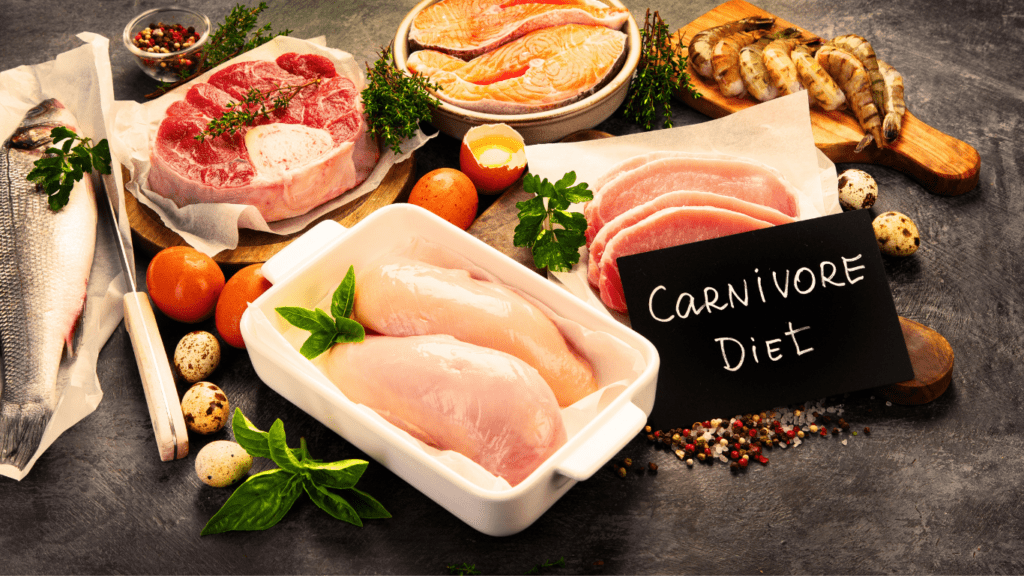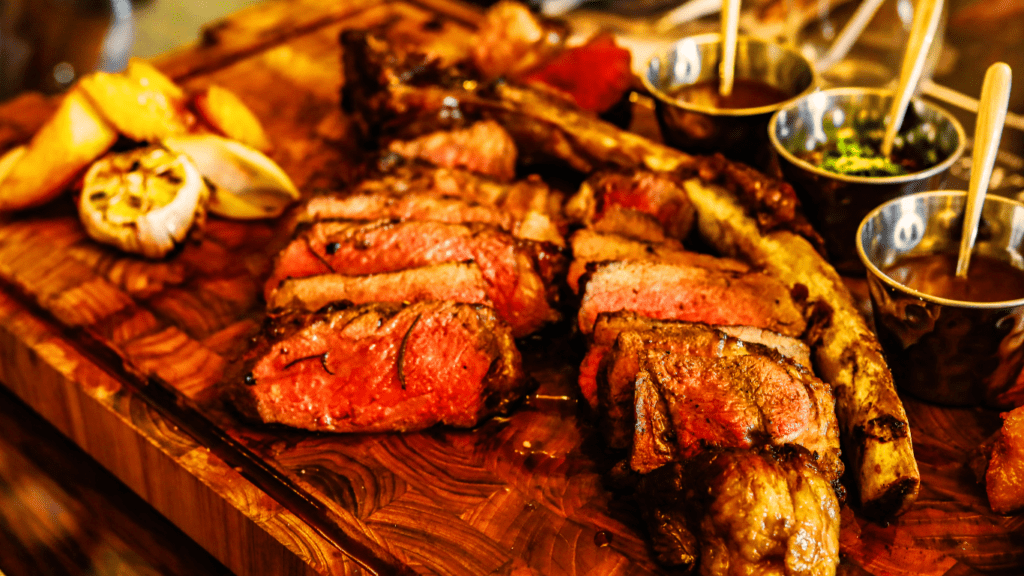Working Out on a Carnivore Diet and Its Impact on Fitness According To Science
In this article, we will explore how working out on a carnivore diet can redefine your fitness journey, offering insights into how this bold nutritional choice might transform your performance and overall health.
In a world where dietary choices have become a topic of intense debate and diverse ideologies, the rise of veganism has been particularly prominent in the Western world. Advocates for plant-based living tout its ethical, environmental, and health benefits, making it a popular lifestyle choice. However, in this article, we’ll step away from ideologies and delve into the realm of science, specifically exploring the effects of working out on a carnivore diet.
Firstly, let’s understand what a carnivore diet entails. At its core, a carnivore diet is one that primarily consists of animal products. This means an exclusive focus on meat, fish, and animal-derived products, while eliminating or significantly reducing the intake of plant-based foods. It’s a diet that challenges conventional notions of a balanced plate but has gained attention for its potential health benefits.
The carnivore diet may seem like a departure from the norm, especially in a world where the emphasis on a diverse and plant-rich diet is widespread. But can individuals truly live and feel healthy on a carnivore diet? According to scientific perspectives, it is possible. The key lies in understanding the nutritional requirements and ensuring that the diet is well-balanced within the confines of animal-derived foods.

When we talk about a carnivore diet, the primary sources of nutrition come from meat, fish, eggs, and other animal products. These foods provide essential nutrients like protein, fat, vitamins, and minerals. Proponents argue that a carnivore diet can meet the body’s nutritional needs without relying on plant-based sources.
Now, let’s shift our focus to the impact of a carnivore diet on individuals who engage in regular physical activity, particularly those who work out. One of the key concerns for athletes and fitness enthusiasts is whether a diet that excludes plant-based foods can support their performance and muscle development.
When working out on a carnivore diet, the emphasis is on obtaining the necessary nutrients from animal sources. Protein, a critical component for muscle repair and growth, is abundantly present in meat and other animal products. Moreover, animal fats contribute to energy production, providing a sustainable fuel source for physical activities.
Subscribe And Get Our Free E-Book:Unlocking The Power Of Nutrition-Supplements, Substitutes, and Superfoods!
Research suggests that a well-formulated carnivore diet can support bodybuilding and sports performance. However, it’s essential to approach this dietary choice with mindfulness. Athletes must carefully plan their meals to ensure they are meeting their nutritional requirements, including essential vitamins and minerals that might be more abundant in plant-based sources.
While a carnivore diet can provide the necessary nutrients for physical activity, individual responses may vary. Some individuals may thrive on this diet, experiencing improved energy levels and performance, while others may not find it suitable. It’s crucial to pay attention to personal health markers and make adjustments as needed.
Working out on a carnivore diet is a subject that intersects science, nutrition, and fitness. By steering away from ideologies and focusing on the physiological effects, individuals can explore whether this dietary choice aligns with their fitness goals. As we continue to navigate the diverse landscape of dietary options, understanding the science behind each choice allows us to make informed decisions that support our overall well-being and performance. So, whether you’re a seasoned athlete or someone exploring new dietary avenues, the key is to find what works best for your body and its unique needs.
How To Start Exercising On A Carnivore Diet Video
Unveiling the Fitness Journey on a Meat-Based Diet
Embarking on the journey of working out on a carnivore diet is like stepping into uncharted territory, a realm where the conventional rules of nutrition may seem to take a back seat. As individuals transition to this distinctive dietary approach, a series of changes unfold – both in the body and in the way one perceives their fitness journey.
In the initial stages of embracing a carnivore diet, many individuals report a shift in energy levels. It’s not uncommon to experience an initial surge in vitality, attributed to the increased intake of animal-based proteins and fats. As the body adapts to this new fuel source, workout enthusiasts often find themselves tapping into a reservoir of sustained energy, offering a fresh perspective on endurance and performance.
Over time, the body undergoes a series of adaptations that contribute to the unique experience of working out on a carnivore diet. One notable change is the potential for enhanced muscle recovery. With a focus on animal-derived proteins rich in essential amino acids, the body gains the building blocks necessary for efficient repair and growth of muscle tissues. This can lead to quicker recovery times between workouts and reduced muscle soreness.
The biological and chemical changes behind the scenes are intricate and fascinating. The absence or minimal intake of carbohydrates prompts the body to enter a state of ketosis. In this metabolic state, the body shifts from relying on glucose for energy to utilizing ketones, derived from the breakdown of fats. This transition is not only instrumental in supporting weight loss but also provides a stable and sustained energy source for physical activities.

Beyond the immediate benefits, a carnivore diet offers a range of advantages for those committed to their fitness goals. One of the primary perks is the simplification of dietary choices. With a focus on animal products, individuals can streamline their meal planning, eliminating the need for complex calculations and meticulous food combinations.
Moreover, the carnivore diet is inherently rich in nutrients essential for overall health and fitness. High-quality proteins, healthy fats, vitamins, and minerals play pivotal roles in supporting not just muscle development, but also immune function, hormone regulation, and other physiological processes integral to well-being.
While the benefits of a carnivore diet are substantial, it’s essential to dispel some common myths surrounding this dietary approach. One prevalent misconception is the idea that a diet exclusively based on animal products lacks diversity and, therefore, may lead to nutritional deficiencies. Contrary to this belief, a well-formulated carnivore diet can provide a comprehensive spectrum of nutrients, often in more bioavailable forms compared to plant-based sources.
Another myth revolves around the notion that a carnivore diet is devoid of fiber, leading to digestive issues. However, proponents argue that the body can adapt to lower fiber intake, and digestive health remains robust with the consumption of nutrient-dense animal products.
Addressing concerns about heart health, some skeptics argue that the high intake of saturated fats in a carnivore diet may pose risks. Yet, emerging research challenges the traditional narrative, suggesting that the relationship between saturated fats and cardiovascular health is more nuanced than previously thought.
Working out on a carnivore diet presents a unique and intriguing approach to fitness and nutrition. The journey involves not only physical adaptations but also a shift in perspective on what the body truly needs to thrive. As individuals explore this path, it’s crucial to remain mindful of personal responses and adjust the approach as needed. Dispelling myths surrounding the carnivore diet allows for a more informed and balanced understanding, empowering fitness enthusiasts to make choices that align with their goals and well-being. So, whether you’re already on the carnivore bandwagon or contemplating the leap, understanding the science and separating fact from fiction paves the way for a fulfilling and sustainable fitness journey.
Answers to Key Questions About Working Out on a Carnivore Diet
Delving into the realm of fitness and nutrition on a carnivore diet unveils a myriad of questions, and seeking answers is crucial for anyone considering or currently immersed in this unique dietary approach.

First on the list of inquiries is a common concern: “Will I lose belly fat on a carnivore diet?” The answer lies in the metabolic changes induced by this dietary approach. Working out on a carnivore diet can contribute to a reduction in overall body fat, including the stubborn belly fat. The absence of carbohydrates prompts the body to rely on stored fat for energy, leading to fat loss over time.
Next up is the aspiration many fitness enthusiasts share: “Can you get jacked on a carnivore diet?” Absolutely. The high-quality protein intake from animal products, coupled with the absence of processed foods and sugars, supports muscle development. Working out on a carnivore diet can lead to a lean and muscular physique, dispelling the notion that plant-based sources are the sole foundation for gains.
“Why are carnivores so muscular?” is a question that often arises when observing the animal kingdom. The answer lies in the nutrient density of their diet. Carnivores consume a diet rich in bioavailable nutrients, promoting muscle growth and overall robustness. The question then naturally follows: Can humans, omnivores by nature, experience similar results on a carnivore diet?
Indeed, humans can achieve muscular development on a carnivore diet, albeit with some differences. While carnivores in the wild exclusively consume animal products, humans, as omnivores, might incorporate some plant-based elements. The key is optimizing nutrient intake from animal sources while recognizing individual needs and tolerances.
A critical aspect of fitness often tied to diet is hormone balance. The question, “Does carnivore raise testosterone?” has gained attention. Research suggests that the consumption of animal fats, particularly saturated fats, can positively impact testosterone levels. However, individual responses may vary, and it’s essential to monitor one’s health markers.
Now, let’s address the concept of a “100% carnivore well-balanced diet.” A well-balanced carnivore diet involves sourcing a variety of nutrients from animal products. It includes different types of meat, organ meats, eggs, and, in some cases, dairy. The danger arises when individuals lean heavily on certain types of meat, neglecting the diversity that contributes to overall nutrition.
While a well-balanced carnivore diet can be safe, it’s essential to highlight potential dangers associated with an imbalanced approach. Lack of variety may lead to nutrient deficiencies, affecting overall health. Adequate hydration is also crucial, as the absence of plant-based foods reduces water intake.
Addressing concerns about the potential negative impact of a carnivore diet, it’s important to emphasize that conclusive evidence is still emerging. While some individuals thrive on a carnivore diet, others may experience adverse effects. The key is individualization, recognizing that not everyone will respond the same way.
In conclusion, working out on a carnivore diet invites a series of questions that merit thoughtful exploration. From shedding belly fat to achieving muscular gains, the journey involves understanding the intricate relationship between diet, exercise, and overall well-being. While a well-balanced carnivore diet can offer numerous benefits, it’s crucial to approach it with mindfulness, acknowledging individual variations and potential risks. As with any dietary approach, consulting with healthcare professionals and monitoring one’s own body is paramount. So, whether you’re a seasoned carnivore or contemplating the leap, the pursuit of answers to these questions ensures a nuanced and informed approach to your fitness journey.
Maximizing Fitness: Working Out on a Carnivore Diet with Tips and Balanced Nutrition
Embracing a fitness journey with a carnivore diet requires not just dedication to the workouts but also thoughtful consideration of how to optimize this dietary approach for maximum results. Let’s dive into some fitness-related tips for seamlessly integrating a carnivore diet into your fitness routine.
Comprehensive Comparison Chart: Working Out on Carnivore Diet vs. Balanced Diet
| Category | Metric | Carnivore Diet | Balanced Diet | Impact on Fitness |
|---|---|---|---|---|
| Macronutrients | Protein (g/day) | 150-200% of RDI | 100-150% of RDI | Supports muscle growth and recovery on both diets, but may be excessive on Carnivore. |
| Fat (g/day) | 120-150% of RDI | 60-80% of RDI | High fat intake in Carnivore Diet provides sustained energy; Balanced Diet offers moderate energy. | |
| Carbohydrates (g/day) | 0-5% of RDI | 100% of RDI | Absence of carbs in Carnivore Diet may affect high-intensity workouts; Balanced Diet provides quick energy. | |
| Micronutrients | Vitamin B12 (mcg/day) | 200% of RDI | 100% of RDI | Both diets provide sufficient Vitamin B12, crucial for energy and red blood cell formation. |
| Iron (mg/day) | 180% of RDI (heme iron) | 100% of RDI (non-heme iron) | Carnivore Diet offers more bioavailable iron, beneficial for muscle oxygenation. | |
| Vitamin C (mg/day) | <10% of RDI | 100% of RDI | Low Vitamin C in Carnivore Diet; important for immune function and collagen synthesis. | |
| Fiber (g/day) | <10% of RDI | 100% of RDI | Lack of fiber in Carnivore Diet may impact digestion; Balanced Diet supports gut health. | |
| Energy Levels | Sustained Energy | High (due to fats) | Moderate (carb-based) | Carnivore Diet offers long-lasting energy from fats; Balanced Diet provides quick bursts from carbs. |
| Quick Energy for Workouts | Low | High | Balanced Diet better supports short, high-intensity workouts with quick-release carbs. | |
| Muscle Development | Muscle Growth Potential | High (due to protein intake) | High (balanced nutrients) | Both diets can support muscle growth, but Carnivore Diet may offer more protein. |
| Recovery Time | Short (due to protein & fats) | Moderate (protein & carbs) | Carnivore Diet may reduce recovery time due to high protein and fat intake. | |
| Hormone Levels | Testosterone | Potential Increase | Stable | High-fat intake in Carnivore Diet may boost testosterone; Balanced Diet maintains stable levels. |
| Body Composition | Fat Loss | High (ketosis effect) | Moderate | Carnivore Diet’s ketosis can enhance fat loss, especially around the abdomen. |
| Heart Health | Cholesterol Levels | Potential Increase (LDL) | Stable or Decrease | Carnivore Diet may raise LDL cholesterol; Balanced Diet generally supports heart health. |
| Digestive Health | Digestive Issues | Possible Constipation | Minimal | Carnivore Diet’s lack of fiber may cause constipation; Balanced Diet supports regularity. |
| Mental Clarity & Focus | Cognitive Function | Improved (Ketosis) | Stable | Carnivore Diet’s ketosis may enhance mental clarity; Balanced Diet provides steady cognitive support. |
| Sustainability | Ease of Adherence | Moderate | High | Carnivore Diet may be restrictive; Balanced Diet offers more variety and is easier to follow long-term. |
| Cost & Accessibility | Food Cost | High | Moderate | Carnivore Diet may be more expensive due to reliance on animal products; Balanced Diet allows for cheaper options. |
| Food Variety | Low | High | Balanced Diet provides more variety, which may be more enjoyable for most people. | |
| Ethical & Environmental | Environmental Impact | High (due to meat production) | Moderate to Low | Carnivore Diet has a higher environmental footprint; Balanced Diet can be more sustainable. |
| Ethical Considerations | Varies (depending on views) | Varies | Ethical concerns are subjective but more prevalent in Carnivore Diet due to animal welfare issues. |
Chart Insights:
- Macronutrients: The Carnivore Diet excels in protein and fat intake but lacks carbohydrates, which can affect high-intensity exercise performance.
- Micronutrients: The Balanced Diet provides more diverse and complete micronutrient intake, especially for Vitamin C and fiber, which are lacking in the Carnivore Diet.
- Energy Levels & Fitness Impact: The Carnivore Diet offers sustained energy through fats, beneficial for endurance but less so for high-intensity activities requiring quick energy. Both diets support muscle growth, but recovery might be faster on the Carnivore Diet due to higher protein and fat intake.
- Body Composition: The Carnivore Diet’s ketosis effect can enhance fat loss, particularly abdominal fat.
- Heart Health: The Carnivore Diet might raise LDL cholesterol levels, requiring monitoring. The Balanced Diet generally supports heart health with a lower risk of increased LDL cholesterol.
- Digestive Health: The Carnivore Diet may cause digestive issues due to low fiber, while the Balanced Diet supports regularity.
- Cognitive Function: Ketosis in the Carnivore Diet may improve mental clarity, while the Balanced Diet provides steady cognitive support.
- Sustainability & Cost: The Carnivore Diet may be less sustainable and more expensive, while the Balanced Diet offers variety, ease of adherence, and lower environmental impact.

First and foremost, prioritize protein. Working out on a carnivore diet emphasizes the significance of high-quality protein sources. Incorporate a variety of meats – beef, poultry, fish, and even organ meats – to ensure you’re meeting your protein requirements for muscle repair and growth. Lean cuts of meat can be your go-to for a protein-packed diet that supports your fitness goals.
In addition to protein, don’t shy away from healthy fats. Contrary to the conventional fear of fats, the carnivore diet encourages the consumption of animal fats for sustained energy during workouts. Include fatty cuts of meat, eggs, and even consider adding butter or ghee to enhance the flavor and nutrient content of your meals.
Hydration is key, especially when working out. While a carnivore diet inherently contains water-rich foods, it’s essential to prioritize additional hydration, especially if you’re engaging in intense physical activities. Water plays a crucial role in supporting overall health and aids in digestion, making it a vital component of your fitness journey.
Now, let’s transition to building a 100% well-balanced carnivore diet for optimal fitness. The principles are straightforward but require attention to detail. Variety is key – aim to include a diverse range of animal products to ensure you’re obtaining a broad spectrum of nutrients. This includes different types of meat, organ meats, and eggs.
Understanding what your body needs is fundamental. Incorporate nutrient-dense foods that provide essential vitamins and minerals. Meat, especially organ meats, is rich in nutrients like iron, zinc, and B-vitamins. Eggs contribute not only high-quality protein but also vitamins such as D and B12.
To know how much of what you need, listen to your body and pay attention to your energy levels, performance, and overall well-being. Adjust your portions based on your activity levels – more protein if you’re engaging in intense workouts, and more fats if you need sustained energy.
| Meal Time | Sample Meal | Description |
|---|---|---|
| Breakfast | Scrambled Eggs with Bacon | Scrambled eggs cooked in butter with crispy bacon strips for protein and healthy fats. |
| Alternative: Omelette with Various Meats | An omelette filled with a variety of meats such as ground beef, sausage, and ham for a protein-packed start. | |
| Lunch | Grilled Chicken Thighs with Salmon | Grilled chicken thighs seasoned with herbs and spices alongside grilled salmon for lean protein and omega-3s. |
| Alternative: Turkey or Duck with Mackerel | Roasted turkey or duck paired with pan-seared mackerel for a flavorful and nutrient-rich lunch option. | |
| Dinner | Ribeye Steak with Shrimp | Juicy ribeye steak served with grilled shrimp for a protein-rich and satisfying dinner. |
| Alternative: New York Strip with Cod | Grilled New York strip steak accompanied by baked cod fillets for a diverse mix of flavors and nutrients. | |
| Snack | Beef Jerky | High-quality beef jerky without additives or preservatives for a convenient and protein-packed snack. |
| Post-Workout | Hard-Boiled Eggs | Hard-boiled eggs provide a quick and portable source of protein for muscle recovery post-workout. |
Let’s break down a well-balanced carnivore diet for a day, focusing on fitness optimization:
Breakfast:
- Scrambled eggs with butter for a protein and fat boost. Eggs are rich in high-quality protein, B-vitamins, and healthy fats.
- Alternative: Omelette with various meats and vegetables.
- Bacon or sausage for additional protein and flavor. Choose high-quality, minimally processed options.
Lunch:
- Grilled chicken thighs for lean protein. Chicken thighs provide a good source of protein and essential nutrients.
- Alternative: Turkey or duck for variety.
- Salmon for omega-3 fatty acids. Salmon is rich in healthy fats and contributes to overall heart health.
- Alternative: Mackerel or sardines for alternative omega-3 sources.
- Include organ meats like liver for a nutrient boost. Organ meats are dense in vitamins and minerals crucial for overall health.
- Alternative: Beef heart or kidney for different nutrient profiles.
Snack:
- Beef jerky for a convenient and portable protein source. Opt for jerky without additives or excessive processing.
Dinner:
- Ribeye steak for a rich source of protein and fats. Ribeye is high in protein, B-vitamins, and healthy fats.
- Alternative: New York strip or sirloin for a leaner option.
- Add some shrimp or other seafood for variety. Seafood provides additional nutrients and adds diversity to the diet.
- Alternative: Cod or tuna for alternative seafood options.
Post-Workout Snack:
- Hard-boiled eggs for a quick protein fix. Eggs are a convenient source of protein and essential nutrients.
Remember, variety is essential, and these are just examples. Be mindful of your body’s signals, and adjust your carnivore diet based on your unique needs and preferences.
As with any dietary change, it’s advisable to consult with a healthcare professional or nutritionist to ensure you’re meeting your individual requirements. The key to success lies in the combination of a well-balanced carnivore diet and a tailored fitness routine, creating a synergistic approach that propels you toward your fitness goals while enjoying the benefits of this distinctive dietary lifestyle.
Final Thoughts: Why Working Out on a Carnivore Diet Could Transform Your Fitness Journey
Embarking on the journey of working out on a carnivore diet is more than just a nutritional choice—it’s a bold commitment to reshaping your body, mind, and overall fitness. As you delve into this diet, you’ll experience a transformation that transcends the physical, unlocking mental clarity, sustained energy, and the primal strength that has fueled our ancestors for millennia.

Choosing to fuel your workouts with a diet rooted in animal-based nutrition is not just about rejecting conventional dietary norms—it’s about embracing a lifestyle that aligns with your body’s natural instincts and nutritional needs. The benefits of working out on a carnivore diet are profound, from rapid muscle recovery and enhanced endurance to fat loss and improved hormonal balance. This diet allows you to strip away the complexities of modern nutrition and focus on what truly nourishes your body, leading to a more focused, powerful, and energetic version of yourself.
However, the journey is as unique as the individual undertaking it. That’s why it’s essential to pay close attention to how your body responds. Adapt your approach as needed, and remember, you’re not alone on this path. We invite you to share your experiences, insights, and progress in the comments section below. Your story might be the inspiration someone else needs to begin their own journey with working out on a carnivore diet.
For those eager to dive deeper into the science behind this lifestyle, there are several resources that can provide further insight. Consider reading “The Carnivore Code” by Dr. Paul Saladino, which delves into the health benefits of an all-meat diet. Another excellent resource is “The Ketogenic Bible” by Dr. Jacob Wilson and Dr. Ryan Lowery, which explains the science behind ketosis and its benefits for athletes. Additionally, studies such as those published in The Journal of Nutrition provide scientific validation for the advantages of a meat-based diet in supporting muscle growth and fat loss.
In the end, committing to working out on a carnivore diet is about more than just the physical changes—it’s about reclaiming your health, optimizing your performance, and connecting with a way of eating that is as natural as it is powerful. Trust in the process, embrace the journey, and watch as this diet transforms your life from the inside out.



